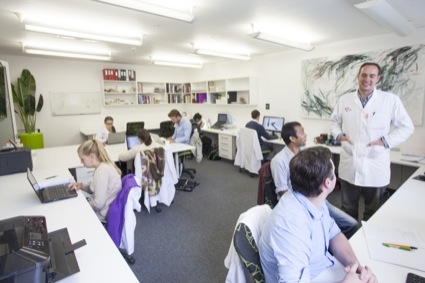
After securing R11.6 million funding from the Technology Innovation Agency (TIA) and funding from Bidvest (R12 m), SAT employed their COO, Heather Coombes, and opened its doors in space rented from UCT in the Chris Barnard Building on the 1st of July 2012. Bidvest provided a second round of funding (R33m; Jan 2014) of and is now a major shareholder together with the founders , UCT and the COO.
SAT employs 8 engineers, a chemist, a cardiac surgeon, 2 polymer specialists, a test engineer, three technicians, a scrub nurse and 3 admin staff. The company occupies 4 offices, 3 laboratories, 2 test laboratories and one large open plan manufacturing area, all within the Cardiovascular Research Unit in the Chris Barnard Building 2nd and 3rd floor.
The manufacturing area is dedicated to laser equipment, firstly a Rofin Start Cut Tube fibre laser, which is valued at R5.3m. This laser enables SAT to cut stents for the stented heart values that are being developed. The second laser is a BW Tec CO2 laser (R1.3m), this is used in the bonding of the balloons used to deploy the stented valves, while the third is a desktop spot welder, which makes use of an ND Yag laser (R290k).
A dedicated synthesis laboratory has been set up to develop a new biocompatible polymer material. Pericardial tissue is prepared, treated and stitched to a stented frame in a dedicated pericardial laboratory, this area consists of 2 laminar flows and an incubator shaker. The third laboratory houses the custom rigs for the manufacturing of polymer valve leaflets and attaching these to the stents.
The durability of the valves is tested in the first of the dedicated test areas using 4 fatigue testers (R760k each), while a Pulse Duplicator (R730k) is used to evaluate the performance of the valves. Custom-made rigs are set up in the second test area: an explanted heart model is extensively used for evaluating prototypes before the devices are used in animal trials while the explanted valve rig allows isolation, viewing the functioning of a mitral valve while testing devices and mimicking various diseased states.
SAT has access to the animal theatres in the same building, highly specialized resources at competitive rates and highly qualified surgical teams that are indispensible in the development of their devices.